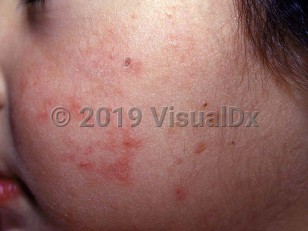Congenital erythropoietic porphyria in Child
Alerts and Notices
Important News & Links
Synopsis

Gunther disease, also called congenital erythropoietic porphyria, is a rare autosomal recessive disorder caused by a deficiency of the enzyme uroporphyrinogen cosynthetase, which is important for heme synthesis.
Uroporphyrin 1 and coproporphyrin 1 accumulate in red cells, bone marrow, and other tissues and are deposited in teeth and bone. In the presence of visible light in the Soret band (400-410 nm) and oxygen, uro- and coproporphyrin 1 release energy, and the resultant reactive oxygen species damage tissues.
The gene for uroporphyrinogen cosynthetase is found on chromosome 10. Various gene mutations have been identified, and these affect enzyme function to a greater or lesser degree. The degree of enzyme activity will determine the clinical phenotype seen.
Red urine in infancy may be the first sign of Gunther disease. Severe photosensitivity is encountered in early childhood, leading to friable skin, bulla formation, and subsequent scarring. Bulla fluid may have a reddish tinge. Repeated episodes of scarring lead to loss of acral areas including digits and the tip of the nose and ears (photomutilation). This is accompanied by hemolytic anemia and splenomegaly. Other signs of Gunther disease include red teeth (erythrodontia due to porphyrin deposition) and eye involvement, which may include photosensitivity, keratoconjunctivitis, corneal ulceration, and cataracts, and may lead to blindness. Hypertrichosis may be present. Shortened stature can be a consequence of the disease.
In the most severe form, Gunther disease causes hemolytic anemia, and hydrops fetalis may occur in utero. A milder form has been recognized where symptoms do not present until later childhood or adulthood.
Uroporphyrin 1 and coproporphyrin 1 accumulate in red cells, bone marrow, and other tissues and are deposited in teeth and bone. In the presence of visible light in the Soret band (400-410 nm) and oxygen, uro- and coproporphyrin 1 release energy, and the resultant reactive oxygen species damage tissues.
The gene for uroporphyrinogen cosynthetase is found on chromosome 10. Various gene mutations have been identified, and these affect enzyme function to a greater or lesser degree. The degree of enzyme activity will determine the clinical phenotype seen.
Red urine in infancy may be the first sign of Gunther disease. Severe photosensitivity is encountered in early childhood, leading to friable skin, bulla formation, and subsequent scarring. Bulla fluid may have a reddish tinge. Repeated episodes of scarring lead to loss of acral areas including digits and the tip of the nose and ears (photomutilation). This is accompanied by hemolytic anemia and splenomegaly. Other signs of Gunther disease include red teeth (erythrodontia due to porphyrin deposition) and eye involvement, which may include photosensitivity, keratoconjunctivitis, corneal ulceration, and cataracts, and may lead to blindness. Hypertrichosis may be present. Shortened stature can be a consequence of the disease.
In the most severe form, Gunther disease causes hemolytic anemia, and hydrops fetalis may occur in utero. A milder form has been recognized where symptoms do not present until later childhood or adulthood.
Codes
ICD10CM:
E80.0 – Hereditary erythropoietic porphyria
SNOMEDCT:
22935002 – Congenital erythropoietic porphyria
E80.0 – Hereditary erythropoietic porphyria
SNOMEDCT:
22935002 – Congenital erythropoietic porphyria
Look For
Subscription Required
Diagnostic Pearls
Subscription Required
Differential Diagnosis & Pitfalls

To perform a comparison, select diagnoses from the classic differential
Subscription Required
Best Tests
Subscription Required
Management Pearls
Subscription Required
Therapy
Subscription Required
References
Subscription Required
Last Updated:07/19/2023

